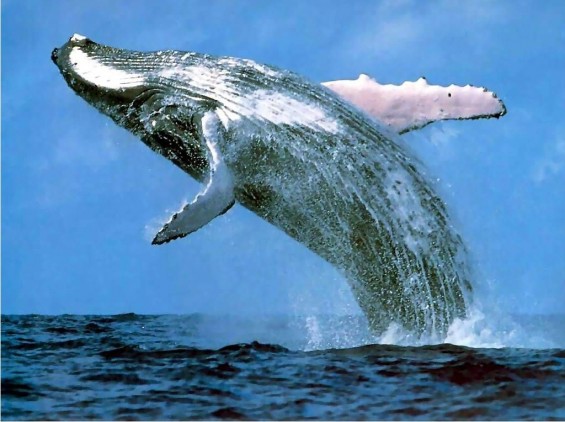AP NEWS
Feds to reroute SF Bay ships to protect whales
By By JASON DEAREN – 18 hours ago
SAN FRANCISCO (AP) — Scientists studying the carcass of a 47-foot fin whale that washed up on a beach in the Point Reyes National Seashore last month found the creature’s spine and ribs severed, likely from the propeller of one of the huge cargo ships that sail those waters.
There have been many victims of such accidents in recent years as migrating blue, fin and humpback whales have been lured close to California’s shore by plentiful krill, the shrimp-like organisms they eat. All three species are endangered.
Now, after a two-year effort spurred by the uptick in accidents, federal maritime officials have approved a plan to protect whales in and around San Francisco Bay. It includes rerouting shipping traffic and establishing better ways to track whale locations.
The changes crafted by the National Oceanic and Atmospheric Administration, shipping industry representatives, whale researchers and the Coast Guard will likely take effect next year, after a final review by the United Nations International Maritime Organization.
“In 2010 it really struck home when a female blue whale carrying a calf was found dead on the beach,” said Maria Brown, NOAA’s superintendent for the Gulf of the Farallones National Marine Sanctuary. “And blue whales’ numbers are so small — to lose a female and a new whale coming into the population really sent home the message that we needed to look at the whale strike issue.”
The shipping industry worked with federal authorities to establish new cargo lanes in one of the world’s busiest ports.
“Nobody wants to hit a whale, just like anybody driving down the highway doesn’t want to hit anything either,” said John Berge, vice president of the Pacific Merchant Shipping Association, who worked on the plan. “We want to do whatever can be done to mitigate the risk, but do it based on good science and good management strategies as opposed to saying, ‘Let’s just try this and see if it works.'”
The plan includes establishing a real-time whale monitoring network that would use trained sailors aboard commercial vessels to report when and where they see whales. Once sighted, a warning would be sent to other ship captains, giving them the option to slow down or take a different route.
Captains now must rely on historical data on whale locations. That means ships may slow down unnecessarily in certain area, delaying delivery of goods.
Though voluntary, industry groups like the shipping association and the Chamber of Shipping America, which also took part in the study, believe shippers will support the concept because it could save them money.
“(The) cost of additional training of the bridge crew pales in comparison to the additional cost associated with lost time if you take ships that normally travel at 20 knots and slow them down to 10 knots over a 70 nautical mile vessel traffic lane,” said Kathy Metcalf, director of maritime affairs for the chamber.
If successful in San Francisco, the reporting network could become mandatory worldwide through the U.N.’s IMO. That’s a goal of those involved in drafting the plan.
“The ships themselves are the most ideal whale sighting platforms to use, and are the lynchpin to the success of this program,” said John Calambokidis, an Olympia, Wash.-based scientist who has studied ship strikes off the West Coast for decades and who participated in the effort.
There are believed to be about 2,000 blue whales in the northeast Pacific, and about 10,000 worldwide. The largest animals on Earth, blue whales can grow up to 90 feet long, still a fraction of the size of cargo ships that can stretch 1,200 feet. There also are about 2,000 fin whales in the northeast Pacific, and about 2,500 humpbacks.
While fin and humpback whales have seen gains in population since the 1990s, the number of blues has declined or remained flat.
How many whales die from collisions each year isn’t known because most accidents go undocumented and whales that are hit often sink. Whale researchers use population models that factor a species’ reproductive rate and its natural mortality to come up with an estimate of how many are likely dying.
In 2010 there were just five confirmed fatal collisions recorded in the area outside San Francisco Bay. But the number of actual strikes of all whale species is likely 10 times higher, Calambokidis said.
PRBO Conservation Science, an environmental research group, conducts annual surveys of whales and other marine life in the sanctuaries around San Francisco Bay. Research director Jaime Jahncke said the number of blue and others whales is four to five times greater than in 2004, increasing the likelihood of ship strikes.
These surveys and other data were used to help map the new shipping lanes by showing vessel owners and federal officials where the whale grounds and shipping lanes were overlapping.
There currently are three shipping lanes coming in and out of San Francisco Bay.
The westbound shipping lane currently ends at the relatively shallow continental shelf, where ships disperse. The new westbound lane would extend three miles past the continental shelf, and contain traffic to a defined area over the whale feeding grounds. The new northbound lane would also be extended miles beyond the shelf, keeping vessels sailing in a straight line for a longer time, rather than allowing them to disperse where the whales congregate.
- Whale mapping data: http://www.accessoceans.org
Copyright © 2012 The Associated Press. All rights reserved.
 Become A Sponsor!
Become A Sponsor!If you have a product or service that is a good fit for our surf community, we have opportunities for you to sponsor this blog! Download our media kit now!

